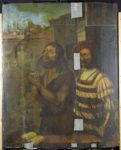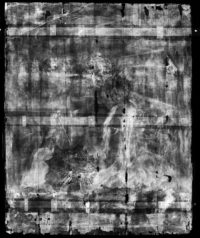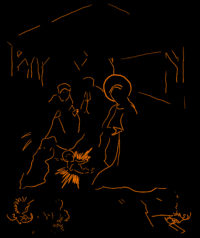 Conservators have discovered a nativity scene underneath a damaged 16th century painting depicting the beheading of Saint John the Baptist. The canvas on wood panel painting is in the collection of The Bowes Museum, originally acquired in the 19th century by museum founders John and Josephine Bowes. Bowes Museum curators have been working with conservators from Northumbria University to assess its condition and treat the deteriorating wood structure behind the painted canvas.
Conservators have discovered a nativity scene underneath a damaged 16th century painting depicting the beheading of Saint John the Baptist. The canvas on wood panel painting is in the collection of The Bowes Museum, originally acquired in the 19th century by museum founders John and Josephine Bowes. Bowes Museum curators have been working with conservators from Northumbria University to assess its condition and treat the deteriorating wood structure behind the painted canvas.
Art Conservator Nicky Grimaldi and forensic scientist Dr Michelle Carlin, are now examining the painting to determine its age, background and history.
Nicky said: “It is clear that the painting is in a poor condition and has been for some time. The panel behind it is made up of several pieces of wood and where these join together there has been significant paint loss over the years.
“Our initial aim was to understand why this is occurring and recommend solutions to ensure the painting can be protected for years to come.
“The first stage of most investigations of this kind is to carry out an x-ray to understand what is going on underneath the layer of paint we see on the surface. That was when we realised there was more to the painting than we originally thought.”
Clearly visible on the x-ray is the Christ child with a halo and rays beaming off his manger, angels, a haloed figure kneeling beside him with an outstretched hand who may be one of the Three Magi. Harder to discern are the outlines of other figures and what might be the stable in the background.
As Nicky explains: “It was common practice to apply gold leaf to these type of religious paintings and in the x-ray we can see that gold is present in the halo around the baby’s head.
“Incredibly we can see lines over the x-ray image which we believe to be preparatory drawings, showing where the painting was probably copied from an original drawing (cartoon).
“Those lines were subsequently filled with another paint layer such as lead white which allows them to be visible on the x-ray.”
The painting will be analyzed further by Northumbria experts. Samples of the paint will be tested for chemical composition and the latest technology from scanning electron microscopes to infrared reflectography will be deployed.

